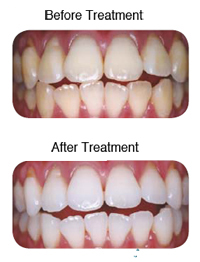What are my teeth whitening options?
If you’re unhappy with the general appearance of your teeth book a consultation with one of our friendly dentists. At the appointment they will assess your teeth and learn your desired outcomes; before creating a treatment plan designed to suit to you and your budget.
It’s important to note that teeth whitening is most effective on clean and healthy surfaces. You should always have your teeth checked before starting any whitening treatment.
There are three main types of whitening:
- In-chair whitening performed by your dentist
- Professional take home kits custom made by your dentist
- At home or over-the-counter products
In-Chair Teeth Whitening
Our professional whitening products use much higher concentrations of bleach than store-bought versions, meaning faster and longer-lasting results. We offer the latest in cosmetic whitening technology with in-chair whitening using Phillips Zoom WhiteSpeed technology.
Our in-chair whitening treatment is completed in one appointment, and results are instant. It combines a patented whitening gel with a unique blue LED lamp to boost the brightness of your smile by up to eight times.
Custom Take-Home Whitening
We also offer custom take-home whitening kits to whiten your teeth at home. This method involves wearing custom trays, and the final result takes approximately 7-10 days. You can also choose to combine in-chair whitening with a personalised take-home kit to brighten your smile even more!
Store-Bought Products
Store-bought products contain far less concentrated materials than what a dentist can prescribe or use in-chair. This means you’ll need to use these kits for a lot longer and with regular frequency to get noticeable results. If you choose to use store-bought whitening products, we strongly recommend you book a consultation. It’s important that before any teeth whitening products are used, the cause of your tooth discolouration is determined, and it’s checked that there’s no decay that needs addressing – no one wants bleach in an open wound.
How In-Chair Teeth Whitening Works
Our Phillips Zoom WhiteSpeed technology combines a specialized gel with a blue LED lamp, brightening your smile by up to eight times. It targets stains caused by red wine, cigarettes, tea, and coffee for exceptional results.
Pre-Treatment Consultation: Before whitening, we assess your dental health, discussing your expectations. Treatment plans vary based on individual needs. We recommend a dental check-up and cleaning for optimal results. Addressing any dental work beforehand is important to prevent sensitivity.
Pre-Treatment Care: Preparing for whitening involves using a sensitive toothpaste and Tooth Mousse in the week before your appointment to enhance protection.
The Whitening Experience: We safeguard your gums and other sensitive areas before applying a concentrated hydrogen peroxide gel. This gel breaks down stains within the enamel. The Zoom WhiteSpeed Whitening LED light accelerates this process, customizable for your comfort. The dentist repeats this up to three times, considering your desired shade and sensitivity.
After Care: Some may experience mild tooth sensitivity for up to 24 hours post-treatment. Relief ACP gel helps reduce this. Using customized bleach trays or sensitive toothpaste afterwards is recommended. For extended brightness, consider our take-home whitening kit for touch-ups and long-term results.
How long will the results last?
How long the teeth whitening lasts depends on several factors, including your diet, medications and whether you smoke. It can also depend on your particular discolouration; generally, those with yellow-coloured teeth see better results than those with brown or grey teeth. As a rule of thumb, you can expect in-chair teeth whitening results to last between one and three years.
What are the side effects of teeth whitening?
Most concerns with teeth whitening side effects stem from improper use of over-the-counter kits. If directions aren’t followed closely, bleach can touch-sensitive areas in the mouth, such as the gums, cheeks and lips, and cause itching, redness and pain.
That’s why in-chair teeth whitening is so highly recommended. It’s conducted within the controlled environment of our dental surgery and performed by one of our experienced dentists, with appropriate guards in place to protect your gums and skin.
There is a chance that tooth whitening will cause sensitivity. Usually, with appropriate aftercare, this sensitivity will dissipate in the following days. However, if you suffer from already sensitive teeth, this may not be an appropriate treatment for you. In this case, you may want to discuss other solutions for discoloured teeth, such as veneers, crowns and dentures.




















